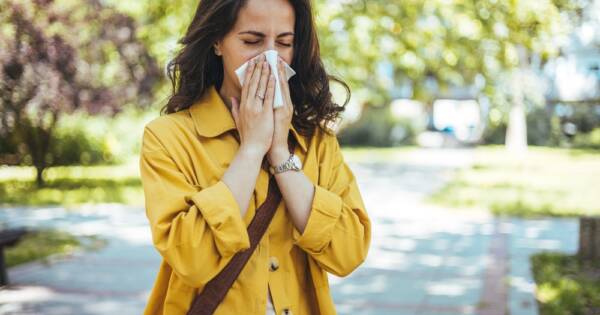If you experience migraines, whether chronic or infrequent, you know just how crippling these painful headaches can be. A migraine can prevent you from living your normal life. And the symptoms of a migraine, like light sensitivity and blinding pain, can be unbearable.
Fortunately, there may way ways to prevent migraines entirely. Making certain lifestyle changes may help reduce the frequency of your migraines, eliminate migraine triggers, or even help soothe your symptoms.
 Maridav / Shutterstock
Maridav / ShutterstockAnd the right lifestyle changes, particularly surrounding your diet, you may also be able to identify what’s triggering migraines. Try these five lifestyle changes to start with, and see if you can find any relief from your terrible migraines.
1. Eat Fresh Foods
Fresh fruits and vegetables are a key component of any healthy diet. But carefully choosing specific fresh foods may be able to reduce your migraines or their symptoms.
Migraine sufferers should try to eat a diet that’s heavily focused on fresh – not processed – foods. Processed foods are thought to be high in substances and ingredients that can trigger migraines, so they’re best avoided.
It’s recommended that migraine sufferers try the Mediterranean diet, which includes a variety of fruits and vegetables, lean meats, and meals made with fresh, simple ingredients. You’ll want to limit your consumption of foods like hot dogs, sausages, bacon, aged cheeses, chocolate, and artificial sweeteners.
2. Choose Water Over Caffeine
Hydration is important for absolutely everyone. The human body is made up of a lot of water, and we need to drink eight 8-ounce glasses of water – or 64 ounces – every day. But if you suffer from migraines, your hydration is even more important¹.
Dehydration is a very common migraine trigger². If you aren’t drinking enough water, you’re increasing the odds that a migraine will happen. 64 ounces may be enough to fully hydrate you. But, if you exercise, if the weather is hot or dry, or you aren’t feeling well, you may need even more water.
And it’s important to choose water over other beverages. Caffeine in particular can bad for migraines. While caffeine can be used to offer pain relief when you’re in the middle of a migraine, it can also trigger one of these terrible headaches.
If you regularly drink a lot of caffeine, you’ll build up a tolerance. And that tolerance can cause withdrawal symptoms when you don’t get enough caffeine every day – including migraines. In order to avoid these withdrawal headaches or full-blown migraines, it’s best to limit your caffeine intake or avoid it entirely.
Coffee, tea, and soda all contain varying amounts of caffeine, so make sure to swap these beverages for a glass of cold water instead.
3. Don’t Skip Meals
Skipping meals can happen any time. If you’re busy, you might forget to take a break for breakfast or lunch. If you aren’t hungry, you might skip a meal without thinking. Or you might practice certain diets, like intermittent fasting, which have you eat during certain hours only.
But if you’re a migraine sufferer, skipping meals is a potentially dangerous habit. Skipping a meal or choosing to fast for a long period can provoke a migraine³.
Instead, follow the American Migraine Foundation’s⁴ recommendations for your meals: eat five or six small meals throughout each day. This will keep your blood sugar stable and prevent crashes or spikes that can trigger migraines and other types of headaches. You also won’t experience any hunger-related pains or potential triggers.
4. Eat Foods High in Omega-3 Fatty Acids
Omega-3 fatty acids are considered an excellent and highly healthy ingredient. They can aid a number of health conditions, from inflammation to heart health to weight loss. Omega-3 fatty acids can also be beneficial for migraine sufferers.
According to recent research⁵, choosing foods that fight inflammation – which includes foods high in omega-3 fatty acids – may be able to reduce migraines. Eating foods that have a lot of omega-3 fatty acids can decrease inflammation throughout the body, and this may reduce one factor that may trigger migraines in some individuals.
And fortunately, these beneficial fatty acids can be found in a number of different foods. You can find omega-3 fatty acids in fish like salmon and mackerel, walnuts, flaxseed, and olive oil.
5. Maintain a Healthy Weight
Maintaining a healthy weight is a good practice for anyone’s overall health. However, your weight may also play a role in the frequency of your migraines.
Research has shown that obesity is a risk factor for migraines⁶. If you’re obese or overweight, you’re at risk for 15 or more headache days every month. This means obesity can increase the chances that you’ll suffer from chronic migraines. So, while your weight may not directly cause migraines, it can influence how often you experience them.
Losing weight and sticking to a healthy weight for your body can eliminate this potential migraine trigger altogether. If you work with your doctor to achieve a healthier weight, you may be able to reduce the frequency of your migraines and give yourself more migraine-free days.
Manage Your Migraines With Small Lifestyle Changes
Adopting healthy habits may have a positive effect on your migraines. Small lifestyle or diet changes like those mentioned here may be able to reduce the number of migraines you experience, or the frequency of your symptoms.
While lifestyle and diet changes may not offer every migraine sufferer relief, they may be worth trying. Migraines can be aggravated or even spurred on by certain triggers, and you may be able to avoid some of these triggers with changes like those mentioned here.
And new information about managing migraines is always being discovered by the medical community. To stay informed about the latest best practices for migraines, it’s important to know what kinds of treatment options and forms of relief are available. It could be as simple as changing your diet, trying a new medication, or giving alternative therapies a chance.


